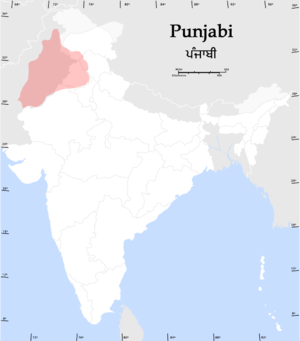Punjabi language
|
||||||||||||||||||||||||||||||||||||||||||||||||||||||||||
Punjabi or Panjabi (ਪੰਜਾਬੀ in Gurmukhi script, پنجابی in Shahmukhi script, पंजाबी in Devanagari script, Pañjābī in transliteration) is an Indo-Aryan language spoken by inhabitants of the historical Punjab region (north western India and in Pakistan ).For Sikhs the Punjabi language stands as the official language in which all ceremonies and rituals would take place.
According to the Ethnologue 2005 estimate[1], there are 88 million native speakers of the Punjabi language, which makes it approximately the 13th most widely spoken language in the world. According to the 2008 Census of Pakistan[4], there are 76,335,300 native Punjabi speakers in Pakistan and according to the 2001 Census of India, there are 29,102,477 Punjabi speakers in India[5].
Punjabi language has many different dialects, spoken in the different sub-regions of greater Punjab. The Majhi dialect is Punjabi's prestige dialect. This dialect is considered as textbook punjabi and is spoken in the historical region of Majha,[6] centralizing in Lahore and Amritsar.
Along with Lahnda and Western Pahari languages, Punjabi is unusual among modern Indo-European languages in being a tonal language.[7][8][9][10]
History
Punjabi is an Indo-Aryan language like many other modern languages of South Asia. It is a descendant of Sauraseni Prakrit, which was the chief language of medieval northern India[11][12][13].
Punjabi emerged as an independent language in the 11th century from the Sauraseni Apabhramsa.[14] The literary tradition in Punjabi started with Fariduddin Ganjshakar (Baba Farid) (1173–1266), many ancient Sufi mystics and later Guru Nanak Dev ji, the first Guru of Sikhism. The early Punjabi literature was principally spiritual in nature and has had a very rich oral tradition. The poetry written by Sufi saints has been the folklore of the Punjab and is still sung with great love in any part of Punjab.
Between 1600 and 1850, Muslim Sufi, Sikh and Hindu writers composed many works in Punjabi. The most famous Punjabi Sufi poet was Baba Bulleh Shah (1680–1757), wrote in the Kafi style. Bulleh Shah practiced the Sufi tradition of Punjabi poetry established by poets like Shah Hussain (1538–1599), Sultan Bahu (1629–1691), and Shah Sharaf (1640–1724). His lifespan also overlapped with the legendary Punjabi poet Waris Shah (1722–1798), of Heer Ranjha fame. Waris Shah's rendition of the tragic love story of Heer Ranjha is among the most popular medieval Punjabi works. Other popular tragic love stories are Sohni Mahiwal, Mirza Sahiba and Sassi Punnun. Shah Mohammad's Jangnama is another fine piece of poetry that gives an eyewitness account of the First Anglo-Sikh War that took place after the death of Maharaja Ranjit Singh.
The linguist George Abraham Grierson in his multivolume Linguistic Survey of India (1904–1928) used the word "Punjabi" to refer to several languages spoken in the Punjab region: the term "Western Punjabi" (ISO 639-3 pnb) covered dialects (now designated separate languages) spoken to the west of Montgomery and Gujranwala districts, while "Eastern Punjabi" referred to what is now simply called Punjabi (ISO 639-3 pan)[15] After Saraiki, Pothohari and Hindko (earlier categorized as "Western Punjabi") started to be counted as separate languages, the percentage of Pakistanis recorded as Punjabi speakers was reduced from 59% to 44%. Although not an official language, Western Punjabi is still the predominant language of Pakistan, and has about twice as many native speakers as Eastern Panjabi, spoken in India.
Association with the Sikhs
Punjabi is not the predominant language of the Sikh scriptures (which though in Gurmukhi script are written in several languages).[16] A few portions of Guru Granth Sahib use the Punjabi dialects, but the book is interspersed with several other languages including Brajbhasha, Khariboli, Sanskrit and Persian.[17] Guru Gobind Singh, the last Guru of the Sikhs composed Chandi di Var in Punjabi, although most of his works are composed in other languages like Braj bhasha and Persian.
However, in the 20th century, the Punjabi-speaking Sikhs started attaching importance to the Punjabi written in the Gurmukhi script as a symbol of their distinct identity.[16] The Punjabi identity was affected by the communal sentiments in the 20th century. Bhai Vir Singh, a major figure in the movement for the revival of Punjabi literary tradition, started insisting that the Punjabi language was the exclusive preserve of the Sikhs.[18] After the partition of India, the Punjab region was divided between Pakistan and India. Although the Punjabi people formed the 2nd biggest linguistic group in Pakistan after Bengali, Urdu was declared the national language of Pakistan, and Punjabi did not get any official status. The Indian Punjab, which then also included what are now Haryana and Himachal Pradesh, became Hindi-majority.
In the 1960s, the Shiromani Akali Dal proposed "Punjabi Suba", a state for Punjabi speakers in India. Paul R. Brass, the Professor Emeritus of Political Science and South Asian Studies at the University of Washington, opines that the Sikh leader Fateh Singh tactically stressed the linguistic basis of the demand, while downplaying the religious basis for the demand—a state where the distinct Sikh identity could be preserved.[16] The movement for a Punjabi Suba led to trifurcation of Indian Punjab into three states: Punjab (India), Haryana and Himachal Pradesh.
Modern Punjabi
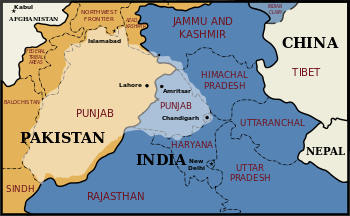
In India, Punjabi is one of the 22 languages with official status in India. It is the first official language of Punjab (India) and Union Territory State Chandigarh and the 2nd official language of Haryana, Himachal Pradesh and Delhi. In Pakistan, Punjabi is the most spoken language and is the provincial language of Punjab (Pakistan) the second largest and the most populous province of Pakistan.
The famous Punjabi writers from Pakistan include:
- Dr. Shahbaz Malik
- Shareef Kunjahi
- Mir Tanha Yousafi
- Sanawar Chadhar
- Alam Lohar
- Abid Tamimi
- Anwar Masood
- Aatish
- Shaista Nuzhat
- Raja Muhammed Ahmed
The famous Indian Punjabi poets in modern times are:
- Prof. Mohan Singh
- Amrita Pritam
- Balwant Gargi
- Shiv Kumar Batalvi
- Surjit Paatar
Geographic distribution
Pakistan
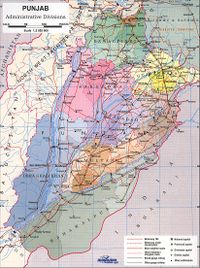
Punjabi is the most spoken language of Pakistan. Punjabi is spoken as first language by over 44.15% of Pakistanis. Punjabis comprise the largest ethnic group in the country. Punjabis are dominant in key institutions such as business, agriculture, industry, government, army, navy, air force, and police which is why about 70% of Pakistanis can understand or speak Punjabi.
The Punjabis found in Pakistan are composed of various social groups, castes and economic groups. Muslim Rajputs, Jat, Tarkhans, Dogars, Gujjars, Gakhars, Khatri or Punjabi Shaikhs, Kambohs, and Arains, comprise the main tribes in the north, while Awans, Gilanis, Gardezis, Syeds and Quraishis are found in the south. There are Pashtun tribes like the Niazis and the lodhis, which are very much integrated into Punjabi village life. People in major urban areas have diverse origins, with many post-Islamic settlers tracing their origin to Afghanistan, Persia, Turkey, Arabia and Central Asia.[19]
| Year | Population of Pakistan | Percentage | Punjabi Speakers |
|---|---|---|---|
| 1951 | 33,740,167 | 67.08% | 22,632,905 |
| 1961 | 42,880,378 | 66.39% | 28,468,282 |
| 1972 | 65,309,340 | 66.11% | 43,176,004 |
| 1981 | 84,253,644 | 48.17% | 40,584,980 |
| 1998 | 132,352,279 | 44.15% | 58,433,431 |
Source: [20] In the National Census of Pakistan (1981) Saraiki, Pothohari and Hindko (Before categorized as "Western Punjabi") got the status of separate languages thats why number of Punjabi speakers got decreased.
| Rank | Division | Punjabi speakers | Percentage |
|---|---|---|---|
| — | Pakistan | 76,335,300 | 44.15% |
| 1 | Punjab | 70,671,704 | 75.23% |
| 2 | Sindh | 3,592,261 | 6.99% |
| 3 | Islamabad Capital Territory | 1,343,625 | 71.66% |
| 4 | North-West Frontier Province | 396,085 | 0.97% |
| 5 | Balochistan | 318,745 | 2.52% |
| 6 | Federally Administered Tribal Areas | 12,880 | 0.23% |
India
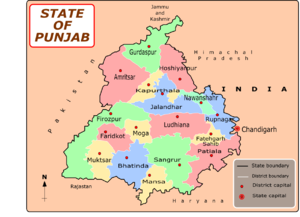
Punjabi is spoken as a native language by over 2.85% of Indians. Punjabi is the official language of the Indian state of Punjab and the shared state capital Chandigarh. It is one of the official languages of the state of Delhi and the second language of Haryana.
The Punjabis found in India are composed of various ethnic groups, tribal groups, social groups (caste) and economic groups. Some major sub-groups of Punjabis in India include Ahirs, Arora, Bania, Bhatia, Brahmin, Chamar, Gujjar, Kalals/Ahluwalias, Kambojs, Khatris, Lobanas, Jats, Rajputs, Saini, Sood and Tarkhan. Most of these groups can be further sub-divided into clans and family groups.
Most of East Punjab's Muslims (in today's states of Punjab, Haryana, Himachal Pradesh, Delhi and Chandigarh) left for West Punjab in 1947. However, a small community still exists today, mainly in Malerkotla, the only Muslim princely state among the seven that formed the erstwhile Patiala and East Punjab States Union (PEPSU). The other six (mostly Sikh) states were: Patiala, Nabha, Jind, Faridkot, Kapurthala and Kalsia.
| Year | Population of India | Punjabi Speakers in India | Percentage |
|---|---|---|---|
| 1971 | 548,159,652 | 14,108,443 | 2.57% |
| 1981 | 665,287,849 | 19,611,199 | 2.95% |
| 1991 | 838,583,988 | 23,378,744 | 2.79% |
| 2001 | 1,028,610,328 | 29,102,477 | 2.83% |
The Punjabi Diaspora
Punjabi is also spoken as a minority language in several other countries where Punjabis have emigrated in large numbers, such as the United States, Australia, the United Kingdom (where it is the second most commonly used language[21]) and Canada, where in recent times Punjabi has grown fast and has now become the fourth most spoken language.[22].
List in order of native speakers
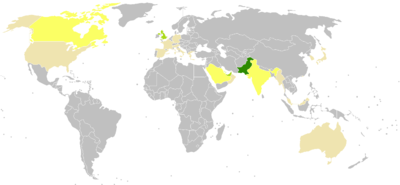
| Rank | Country | First language |
|---|---|---|
| 1 | 76,335,300 | |
| 2 | 29,109,672 | |
| 3 | 2,300,000 | |
| 4 | 1,100,000 | |
| 5 | 720,000 | |
| 6 | 640,000 | |
| 7 | 620,000 | |
| 8 | 260,000 | |
| 9 | 185,000 | |
| 10 | 140,000 | |
| 11 | 120,000 | |
| 12 | 90,000 | |
| 13 | 80,000 | |
| 14 | 75,000 | |
| 15 | 75,000 | |
| 16 | 70,000 | |
| 17 | 70,000 | |
| 18 | 68,000 | |
| 19 | 65,000 | |
| 20 | 60,000 | |
| 21 | 55,000 | |
| 22 | 50,000 | |
| 23 | 45,000 | |
| 24 | 40,000 | |
| 25 | 35,000 |
Dialects: linguistic classification
In Indo-Aryan dialectology generally, the presence of transitional dialects creates problems in assigning some dialects to one or another "language".[23][24] However, over the last century there has usually been little disagreement when it comes to defining the core region of the Punjabi language. In modern India, the states are largely designed to encompass the territories of major languages with an established written standard. Thus Indian Punjab is the Punjabi language state (in fact, the neighboring state of Haryana, which was part of Punjab state in 1947, was split off from it because it is a Hindi speaking region). Some of its major urban centers are Ludhiana, Amritsar, Chandigarh, Jalandhar, and Patiala. In Pakistan, the Punjabi speaking territory spans the east-central districts of Punjab Province. Lahore, Rawalpindi, Faislabad, Gujranwala, Sargodha, Sialkot, Jhang, Jhelum and Gujrat. Lahore the historic capital of Punjab is the largest Punjabi speaking city in the world. Lahore has 86% native Punjabis of total population of the city. and Islamabad the Capital of Pakistan has 71% Native Punjabis of total population.
Major Punjabi dialects
- Majhi
- The Majhi dialect is Punjabi's prestige dialect and spoken in the heart of Punjab where most of the Punjabi population lives. The Majhi dialect, the dialect of the historical region of Majha,[6] which spans the Lahore, Sheikhupura, Kasur, Okara, Gujranwala, Wazirabad, Sialkot, Narowal, Gujrat and to some extant in Jhelum District of Pakistani Punjab and Amritsar, Tarn Taran Sahib, and Gurdaspur Districts of the Indian State of Punjab.
- Pothowari
- This dialect is spoken in north Pakistani Punjab. mainly The area where Pothowari is spoken extends in the north from Muzaffarabad to as far south as Jhelum, Gujar Khan and Rawalpindi. [phr] 49,440 (2000 WCD). Murree Hills north of Rawalpindi, and east to Bhimber. Poonchi is east of Rawalakot. Potwari is in the plains around Rawalpindi. Alternate names: Potwari, Pothohari, Potohari, Chibhali, Dhundi-Kairali. Dialects: Pahari (Dhundi-Kairali), Pothwari (Potwari), Chibhali, Punchhi (Poonchi), Jhelumi, Mirpuri. Pahari means 'hill language' referring to a string of divergent dialects, some of which may be separate languages. A dialect chain with Panjabi and Hindko. Closeness to western Pahari is unknown. Lexical similarity 76% to 83% among varieties called 'Pahari', 'Potwari', and some called 'Hindko' in Mansehra, Muzaffarabad, and Jammun. Classification: Indo-European, Indo-Iranian, Indo-Aryan, Northern zone, Western Pahari.
- Jhangochi or Rachnavi
- Jhangochi (جھنگوچی) dialect is spoken in Pakistani Punjab. Jhangochi or Rachnavi is the oldest and most idiosyncratic dialect of the Punjabi. It is spoken throughout a widespread area, starting from Khanewal and Jhang at both ends of Ravi and Chenab to Gujranwala district. It then runs down to Bahawalnagar and Chishtian areas, on the banks of river Sutlej. This entire area has almost the same traditions, customs and culture. The Jhangochi dialect of Punjabi has several aspects that set it apart from other Punjabi variants. This area has a great culture and heritage, especially literary heritage, as it is credited with the creation of the famous epic romance stories of Heer Ranjha and Mirza Sahiba. It is spoken in the Bar areas of Punjab, i.e., areas whose names are often suffixed with 'Bar', for example Sandal Bar, Kirana Bar, Neeli Bar, Ganji Bar and also from Khanewal to Jhang includes Faisalabad and Chiniot.
- Shahpuri
- This dialect is spoken in Pakistani Punjab. The Shahpuri language has been spoken by the people of the town Shahpur. This language has been spoken by the people of District Sargodha including Dera Chanpeer Shah, Khushab, Jhang, Mianwali, Attock, parts of Faisalabad (formerly Lyallpur), parts of Dera Ismail Khan, Dera Ghazi Khan, Bahawalnagar, Chakwal, Mianwali, Sargodha, Khushab and Mandi Bahauddin districts.
- Hindko
- Classified under Lahnda languages by many linguists; perhaps differs from Punjabi. Hindko dialect is spoken in north west Pakistani Punjab and North-West Frontier Province mainly this dialect is spoken in districts of Peshawar, Attock, Nowshehra, Mansehra, Balakot, Abbottabad and Murree and the lower half of Neelum District and Muzafarabad.
- Malwi
- Malwi spoken in the eastern part of Indian Punjab. Main areas are Patiala Ludhiana, Ambala, Bathinda, Ganganagar, Malerkotla, Fazilka, Ferozepur. Malwa is the southern and central part of present day Indian Punjab. It also includes the Punjabi speaking northern areas of Haryana, viz. Ambala, Hissar, Sirsa, Kurukshetra etc. Not to be confused with the Malvi language, which shares its name.
- Doabi
- Doabi spoken in Indian Punjab. The word "Do Aabi" means "the land between two rivers" and this dialects is spoken between the rivers of Beas and Sutlej. It includes Jalandhar, Nawanshahr, Kapurthala and Hoshiarpur districts.
- Pwadhi
- Powadh or Puadh or Powadha is a region of Punjab and parts of Haryana between the Satluj and Ghaggar rivers. The part lying south, south-east and east of Rupnagar adjacent to Ambala District (Haryana) is Powadhi. The Powadh extends from that part of the Rupnagar District which lies near Satluj up to the Ghaggar river in the east, which separates the states of Punjab and Haryana. Parts of Fatehgarh Sahib district, and parts of Patiala districts like Rajpura are also part of Powadh. The language is spoken over a large area in present Punjab as well as Haryana. In Punjab, Kharar, Kurali, Ropar, Nurpurbedi, Morinda, Pail, Rajpura, and Samrala are the areas where the Puadhi language is spoken and the area itself is claimed as including from Pinjore, Kalka to Bangar area in Hisar district which includes even Nabha and Patiala in it.
- Dogri
- Although Dogri is generally considered a separate language having its own vocabulary, some sources consider it a dialect of Punjabi. It is spoken by about 3.5 million peoples in the Jammu region of India.
- Saraiki/Multani
- Saraiki or Multani is the transfusion of jhangochi dialect of Punjabi and Sindhi. Saraiki is the new name, for centuries, Multani was in use. It is now considered to be a separate language instead of merely a dialect of Punjabi. It is mostly spoken in southern and western districts of Punjab,which comprises Multan, Lodhran, Bahawalpur, Mianwali, Bhakkar, Layyah, Dera Ghazi Khan, Muzaffargarh, Rahim Yar Khan, Vehari, some parts of Khanewal, Bahawalnagar and Khushab districts. It is also spoken by majority of population of Dera Ismail Khan district in NWFP province, kachi plain of Balochistan, northern part Sindh, and cities of Hyderabad and Karachi.
- Dhani
- The people of Pothohar speak Pothohari dialect. However, the people of Chakwal or the Dhanni area in particular do not speak Pothohari and are ethnologically not regarded as Potoharis. They speak a distinctive Chakwali or Dhanni dialect of Punjabi, which is closer to Shahpuri, a dialect spoken in the Shahpur-Salt Range area and also has a slight element of Saraiki and Pothohari.
- Punjabi University classification
Punjabi University, Patiala, State of Punjab, India takes a very liberal definition of Punjabi in that it classifies Saraiki, Dogri and Pothohari/Pothwari as Punjabi. Accordingly, the University has issued the following list of dialects of Punjabi:[25]
The "Lahnda" constructThe name "Punjab" means "5 waters" in Persian (panj ab) and refers to five major eastern tributaries of the Indus River. The historical Punjab region, now divided between Pakistan and India, is defined physiographically by the Indus River and these five tributaries. The bulk of the Panjab, 3.5 rivers are located in Pakistan. One of the five, the Beas River, is a tributary of another, the Sutlej River, and lies entirely in present day India, well within the eastern half of historical Punjab. The British linguist George Abraham Grierson came to the conclusion that a group of dialects known collectively as "western Punjabi" or Lahnda spoken north and west of the Punjab heartland, in the Indus valley itself and on the lower reaches of the other four tributaries (excluding the Beas River), in fact constituted a language distinct from eastern or jurdga Punjabi. He christened this group of dialects "Lahindā" in a volume of the Language Survey of India (LSI) published in 1919.[15] He grouped as "southern Lahnda" the dialects that are now recognized as multani or Saraiki. The northern Lahnda sub-Group has eveloved into Modern Panjistani (or pahiri/mirpur/pothoahri)and modern Hindko .Grierson tentatively identified the boundary between Punjabi and "Lahnda" as a north-south line running from the Gujranwala District to the former Montgomery District (near the town on Sahiwal). This line lies well west of Lahore and within the boundary of Pakistan.[26] In the aftermath of the independence of Pakistan and subsequent Partition of 1947, some investigators supposed that the Punjabi speakers in new Pakistan might give up their native dialects and adopt one or another "Lahnda" dialect; but this did not occur.[26] Classification by EthnologueBecause of the stature of Ethnologue as a widely accepted authority on the identification and classification of dialects and languages, their divergent views of the geographical distribution and dialectal naming of the Punjabi language merit mention. They designate what tradition calls "Punjabi" as "Eastern Punjabi" and they have implicitly adopted the belief (contradicted by other specialists[27]) that the language border between "western Panjabi" and "eastern Panjabi" has shifted since 1947 to coincide with the international border.[28] Examples
Phonology
There are also nasalized vowels.
Punjabi has three phonemically distinct tones that developed from the lost murmured (or "voiced aspirate") series of consonants. Phonetically the tones are rising or rising-falling contours and they can span over one syllable or two, but phonemically they can be distinguished as high, mid, and low. A historical murmured consonant (voiced aspirate consonant) in word initial position became tenuis and left a low tone on the two syllables following it: ghoṛā [kòːɽɑ̀ː] "horse". A stem final murmured consonant became voiced and left a high tone on the two syllables preceding it: māgh [mɑ́ːɡ] "October". A stem medial murmured consonant which appeared after a short vowel and before a long vowel became voiced and left a low tone on the two syllables following it: maghāṇā [məɡɑ̀ːɳɑ̀ː] "to be lit". Other syllables and words have mid tone.[29] GrammarWriting systemThere are several different scripts used for writing the Punjabi language, depending on the region and the dialect spoken, as well as the religion of the speaker. In the Punjab province of Pakistan, the script used is Shahmukhi and differs from the standard Nastaʿlīq script as it has four additional letters.[30] The eastern part of the Punjab region, located in India, is divided into three states. In the state of Punjab, the Gurmukhī script is generally used for writing Punjabi. Punjabi Hindus, who are mainly concentrated in the neighbouring Indian states such of Haryana and Himachal Pradesh, as well as the national capital territory of Delhi, sometimes use the Devanāgarī script to write Punjabi.[30] While a Punjabi GCSE is available to students in the United Kingdom; its written exam is in Gurmukhi only. Punjabi in modern culturePunjabi is becoming more acceptable among Punjabis in modern media and communications. Punjabi has always been an integral part of Indian Bollywood cinema. In recent years a trend of Bollywood songs written totally in Punjabi can be observed. Punjabi pop and folk songs are very popular both in India and Pakistan at the national level. A number of television dramas based on Punjabi characters are telecast by different channels. The number of students opting for Punjabi literature has increased in Pakistani Punjab. Punjabi cinema in India has also seen a revival and more and more Punjabi movies are being produced. Differences in Punjabi in India and PakistanWhile the language is the same on both sides of the border, specialist borrowings of terms are drawn from Sanskrit in India, while in Pakistan are drawn from Persian and Arabic. One example is the use of the word Tarik (ਤਰੀਖ਼/تریخ) in Pakistan, and use of the word Itihaas (ਇਤਿਹਾਸ/اتہاس) in India for the word history. Sample textThis sample text was taken from the Punjabi Wikipedia article on Lahore; translated to English and transliterated to Latin. Gurmukhi: ਲਹੌਰ ਪਾਕਿਸਤਾਨ ਪੰਜਾਬ ਦਾ ਦਾਰੁਲ ਹਕੂਮਤ ਐ। ਲੋਕ ਗਿਣਤੀ ਦੇ ਨਾਲ ਕਰਾਚੀ ਤੋਂ ਬਾਅਦ ਲਹੌਰ ਦੂਜਾ ਸਬ ਤੋਂ ਵੱਡਾ ਸ਼ਹਿਰ ਏ। ਲਹੌਰ ਪਾਕਿਸਤਾਨ ਦਾ ਸਿਆਸੀ, ਰਹਤਲੀ ਤੇ ਪੜ੍ਹਾਈ ਦਾ ਗੜ੍ਹ ਏ ਤੇ ਇਸੇ ਲਈ ਇਨੂੰ ਪਾਕਿਸਤਾਨ ਦਾ ਦਿਲ ਵੀ ਕਿਆ ਜਾਂਦਾ ਏ। ਲਹੌਰ ਦਰੀਆਏ ਰਾਵੀ ਦੇ ਕੰਡੇ ਤੇ ਵਸਦਾ ਏ ਉਸਦੀ ਲੋਕ ਗਿਣਤੀ ਇਕ ਕਰੋੜ ਦੇ ਨੇੜੇ ਏ । Devanagari: लहौर पाकिसतान पजाब दा दारुल हकूमत ऐ। लोक गिणती दे नाल कराची तों बाअद लहौर दूजा सब तों वडा स़हिर ए। लहौर पाकिसतान दा सिआसी, रहतली ते पड़्हाई दा गड़्ह ए ते इसे लई इनू पाकिसतान दा दिल वी किआ जांदा ए। लहौर दरीआए रावी दे कडे ते वसदा ए उसदी लोक गिणती इक करोड़ दे नेड़े ए । Shahmukhi: لہور پاکستان پنجاب دا دارالحکومت اے۔ لوک گنتی دے نال کراچی توں بعد لہور دوجا سب توں وڈا شہر اے۔ لہور پاکستان دا سیاسی، رہتلی تے پڑھائی دا گڑھ اے تے ایسے لئی اینوں پاکستان دا دل وی کیا جاندا اے۔ لہور دریاۓ راوی دے کنڈے تے وسدا اے اسدی لوک گنتی اک کروڑ دے نیڑے اے ۔ Transliteration (IAST): lahaura pākisatāna pajāba dā dārula hakūmata ai. lōka giṇatī dē nāla karācī tōṁ bā'ada lahaura dūjā saba tōṁ vaḍā śahira ē. lahaura pākisatāna dā si'āsī, rahatalī tē paṛhā'ī dā gaṛha ē tē isē la'ī inū pākisatāna dā dila vī ki'ā jāndā ē. lahaura darī'ā'ē rāvī dē kaḍē tē vasadā ē usadī lōka giṇatī ika karōṛa dē nēṛē ē . Dictionaries
Pothohari (Nothern Lahnda,pahari or Modern panjistani) dictionary by Sharif Shad See also
Notes
References
Further reading
External links
|
||||||||||||||||||||||||||||||||||||||||||||||||||||||||||||||||||||||||||||||||||||||||||||||||||||||||||||||||||||||||||||||||||||||||||||||||||||||||||||||||||||||||||||||||||||||||||||||||||||||||||||||||||||||||||||||||||||||||||||||||||||||||||||||||||||||||||||||||||||||||||||||||||||||||||||||||||||||||||||||||||||||||||||||||||||||||||||||||||||||||||||||||||||||||

